Coinbase online payment system

235 systems total

Payments arrive at the speed of an email (just a few seconds) and are confirmed within the hour. No more waiting three business days for checks.
Coinbase charges just 0.5% when you buy or sell bitcoin via bank account transfer. After that all bitcoin-to-bitcoin transactions are free.
Our website works great on modern smartphones (iPhone, Android, etc). Just visit coinbase.com from your mobile browser.
Use your bank account to purchase bitcoins. Transactions are processed within two to three business days. (coming soon)
Easily create "buy now" or donate buttons. We also offer full shopping cart integration. (coming soon)
About $2 million a day (USD) is already being transacted in bitcoin. It's quickly becoming an international currency.
Bitcoin
USA
private and business
0.5% when you buy or sell bitcoin via bank account transfer
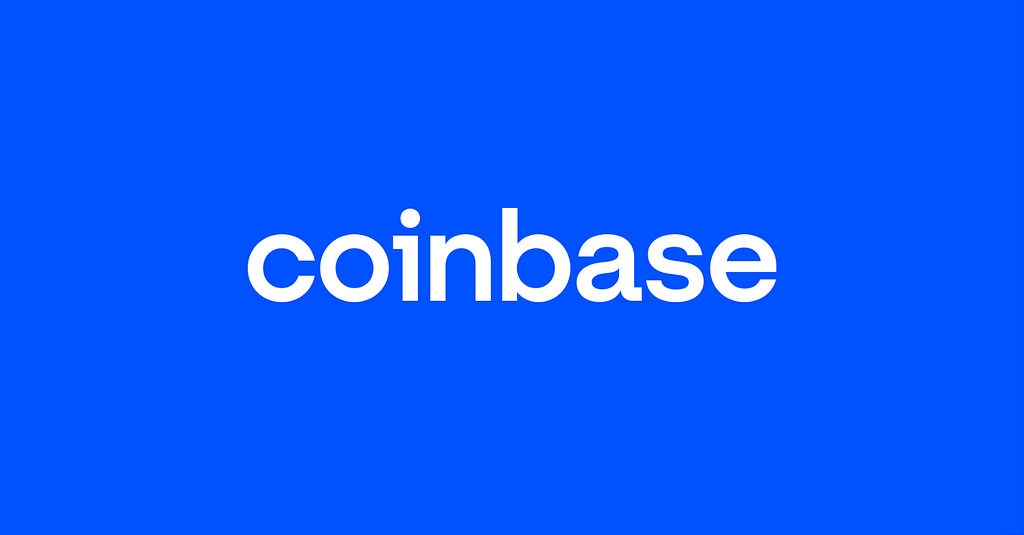
Tl:dr Earlier today, the Wall Street Journal published an article highlighting client-driven activities, which they seem to confuse with proprietary trading.
Unlike many of our competitors, Coinbase does not operate a proprietary trading business or act as a market maker. In fact, one of the competitive strengths of our Institutional Prime platform is our agency only trading model, where we act only on behalf of our clients. As a result, our incentives and our clients’ incentives are aligned by design.
Coinbase does, from time to time, purchase cryptocurrency as principal, including for our corporate treasury and operational purposes*. We do not view this as proprietary trading because its purpose is not for Coinbase to benefit from short-term increases in value of the cryptocurrency being traded.
Expanding institutional participation in web3 beyond HODLing
As more institutions have become interested in investing in crypto, we are rolling out new solutions to help. One way we intend to serve our institutional clients is through a small newly formed team called Coinbase Risk Solutions (CRS).
CRS offers solutions to sophisticated institutional investors who seek exposure to the crypto asset class. Some of these investors are still getting familiar with crypto markets and ask for our assistance in managing risks and participating in protocols. The goal of CRS is to expand institutional participation in web3 beyond HODLing.
In doing this, we are following a well trodden path on Wall Street where financial services firms provide clients multiple ways to get exposure to new asset classes and manage certain risks. We have tools and policies in place that mirror best practices in the financial services industry and are designed to manage conflicts of interest.
*In December of 2021 we accurately outlined our investment activity in digital assets as part of our testimony to Congress, which you can find here.
In response to the Wall Street Journal was originally published in The Coinbase Blog on Medium, where people are continuing the conversation by highlighting and responding to this story.
Read more on CoinbaseTl;Dr: Coinbase becomes the first major global crypto exchange to successfully register with the Dutch Central Bank (De Nederlandsche Bank — DNB), allowing us to offer our crypto products and services to the Dutch market.

By Nana Murugesan, Vice President, International and Business Development
Hoi, Nederland!
We are excited to announce that Coinbase has successfully registered with the Dutch Central Bank (De Nederlandsche Bank — DNB) as a crypto service provider. This registration will allow Coinbase to offer our full suite of retail, institutional, and ecosystem products to customers in the Netherlands. We are proud to be the first major global crypto exchange to receive DNB registration approval — a significant milestone in Coinbase’s continued international expansion.
Coinbase views regulation of the industry as an “enabler” for crypto’s growth, setting clear ground rules that will create an environment which encourages innovation and strengthens trust in the sector from both the public and policymakers.
“As part of Coinbase’s ambition to be the world’s most trusted and secure crypto platform, we have taken strides to work collaboratively with government, policymakers and regulators to shape the future in a responsible way. Coinbase prides itself on being a compliance-led business. The Netherlands is a critical international market for crypto, and I am really excited for Coinbase to bring the potential of the crypto economy to the market here,” said Nana Murugesan, Vice President, International and Business Development at Coinbase.
Coinbase serves customers across almost 40 European countries through dedicated hubs in Ireland, the UK, and Germany. Additional registrations or license applications are in progress in several major markets, in compliance with local regulations.
— — — — — — — — — — — -
Coinbase Europe Limited and Coinbase Custody International Ltd are listed in DNB’s public register as a crypto service provider. DNB supervises Coinbase Europe Limited and Coinbase Custody International Ltd in compliance with the Anti-Money Laundering and Anti-Terrorist Financing Act (Wet ter voorkoming van witwassen en financiering van terrorisme — Wwft) and the Sanctions Act (Sanctiewet 1977 — Sw). The crypto services of Coinbase are not subject to prudential supervision by DNB or conduct supervision by the AFM. This means that financial operational risks in respect of the crypto services are not monitored and there is no specific financial consumer protection.
Coinbase gains regulatory approval in the Netherlands 🇳🇱 was originally published in The Coinbase Blog on Medium, where people are continuing the conversation by highlighting and responding to this story.
Read more on CoinbaseTL;DR: Coinbase Cloud enables web3 developers to build their web3 applications with instant and reliable read/write blockchain access using Node.
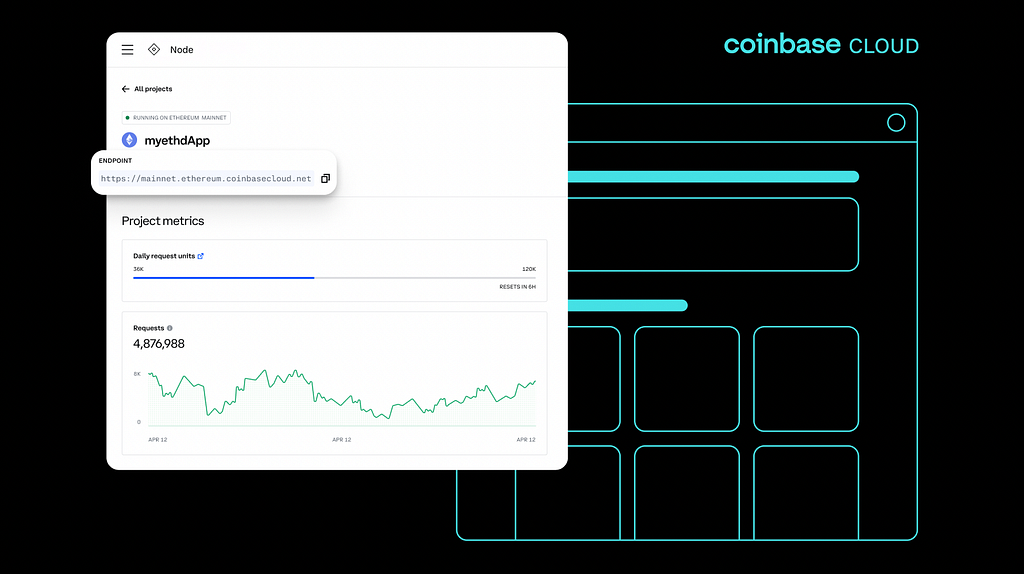
By Luv Kothari, Group Product Manager, Coinbase Cloud; Sriram Raman, Product Manager, Coinbase Cloud
Web3 development is complex. One needs to learn new programming languages, blockchain technologies, and on top of that, there are many protocols to support. Coinbase Cloud is committed to helping Web3 developers do what they do best… BUIDL. That’s why we’re taking our experience developing Web3 products for DeFi, staking and blockchain infrastructure and making this technology accessible for free to developers around the world, starting with the launch of Node.
Node empowers developers to build and monitor their Web3 applications from an easy-to-use platform with instant read/write access to blockchains and powerful data indexers to speed up responses.
Node, formerly known as Query & Transact, has been serving dedicated, paid nodes to enterprises for read/write access to 25+ blockchains since 2020.
Since then, we’ve been listening to the developer community and heard a demand for a developer version of Node. Which is why we are launching a free plan for developers building on Ethereum, providing self-serve and instant accessibility to blockchain nodes via API. Additionally, we are launching new Advanced APIs to simplify querying the blockchain and powerful new NFT APIs to developers around the world.
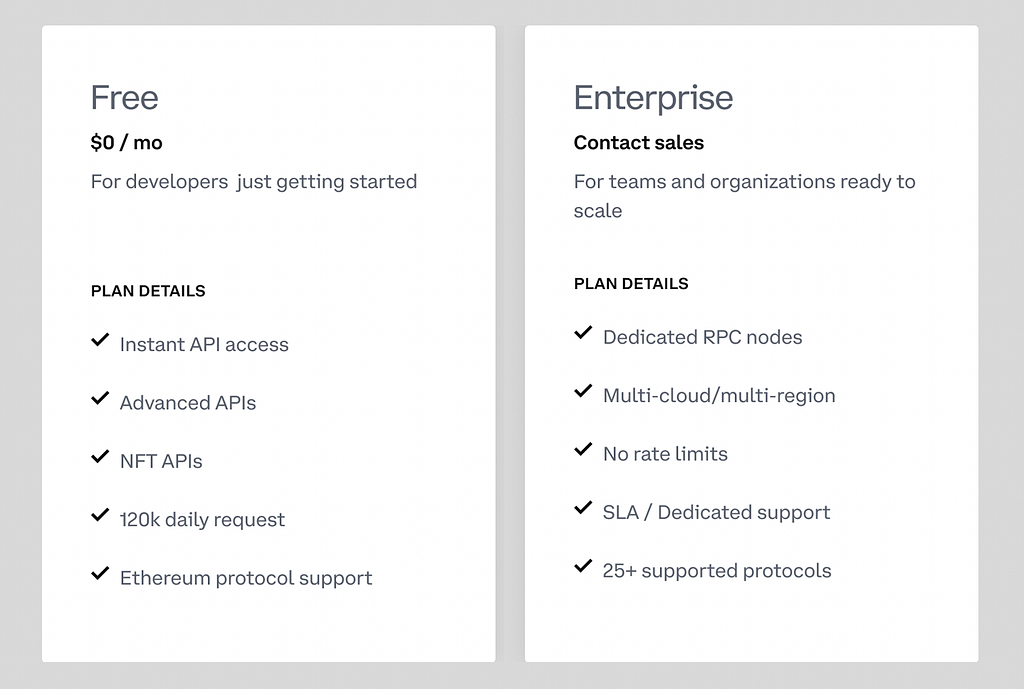
Node developer platform provides self-serve API access credentials, metrics dashboards to monitor and manage web3 projects, and developer resources to get started with web3 development.
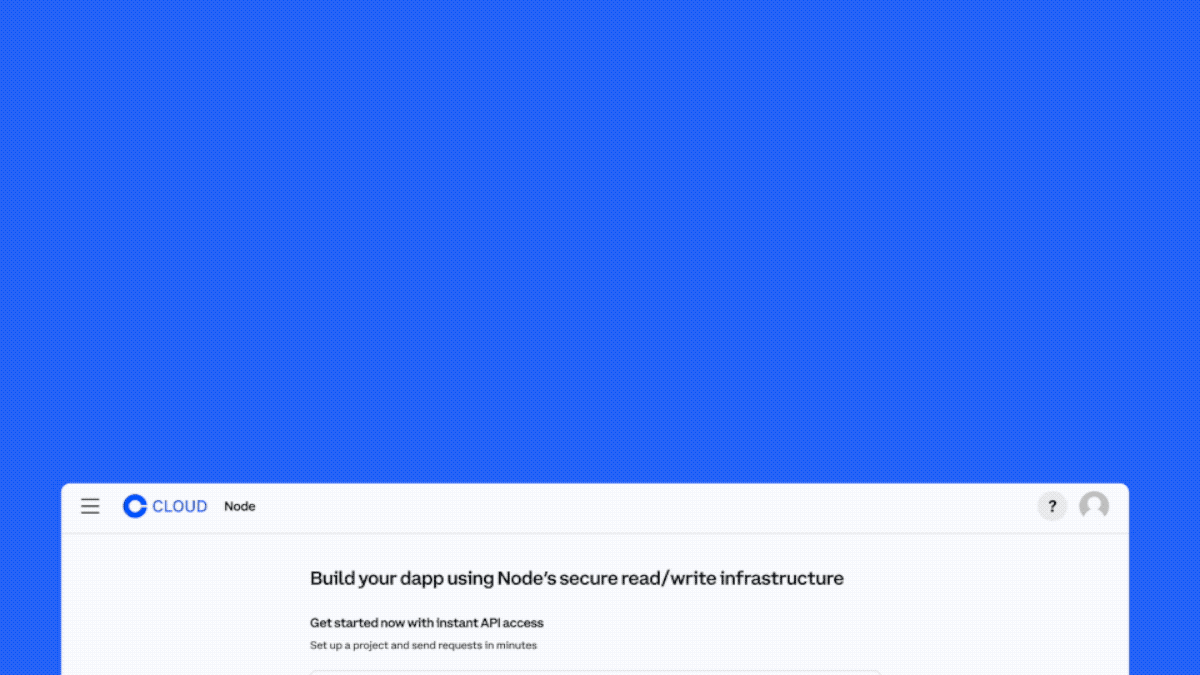
Node is available starting today around the world. We believe the most exciting projects in web3 are on the horizon and we can’t wait to see what the community builds! Get started for free.
Coinbase Cloud makes it simple to build dapps. In addition to shared and dedicated nodes, Coinbase Cloud offers a fiat on-ramp with Pay SDK, trading APIs, Wallet SDK, and more. Our vision is to provide everything devs need to quickly, easily, and securely build amazing web3 apps.
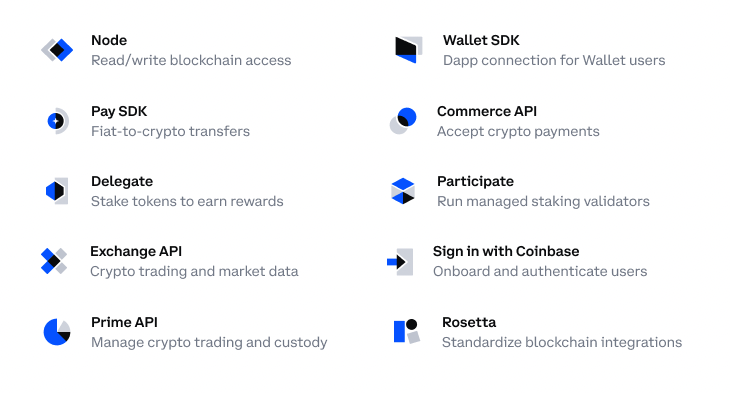
Get started with Node on Coinbase Cloud or check out the developer documentation for more information.
*This is not a guarantee. Needs may vary significantly on a case-by-case basis.
Features and services may vary depending on the selected plan, and some plans may be subject to subscription fees and/or additional fees, costs or customized pricing.
Legalese/Disclaimers
This document and the information contained herein is not a recommendation or endorsement of any digital asset, protocol, network, or project. However, Coinbase may have, or may in the future have, a significant financial interest in, and may receive compensation for services related to one or more of the digital assets, protocols, networks, entities, projects, and/or ventures discussed herein. The risk of loss in cryptocurrency, including staking, can be substantial and nothing herein is intended to be a guarantee against the possibility of loss.
This document and the content contained herein are based on information which is believed to be reliable and has been obtained from sources believed to be reliable, but Coinbase makes no representation or warranty, express, or implied, as to the fairness, accuracy, adequacy, reasonableness, or completeness of such information, and, without limiting the foregoing or anything else in this disclaimer, all information provided herein is subject to modification by the underlying protocol network.
Any use of Coinbase’s services may be contingent on completion of Coinbase’s onboarding process and is Coinbase’s sole discretion, including entrance into applicable legal documentation and will be, at all times, subject to and governed by Coinbase’s policies, including without limitation, its terms of service and privacy policy, as may be amended from time to time.
Coinbase Cloud launches platform for web3 developers was originally published in The Coinbase Blog on Medium, where people are continuing the conversation by highlighting and responding to this story.
Read more on CoinbaseTL;DR: To create an open financial system for the world, we need to ensure web3 is usable by everyone. This means building an identity experience that’s intuitive, forgiving, and trustworthy, combining the best of web2 and web3. Our first step is to make it easy for anyone to claim a web3 (ENS) username for free, but there’s more work to be done.

By Alex Reeve, Group Product Manager, Identity
If you’ve used crypto, you’ve probably experienced the anxiety that comes from sending tokens or NFTs to intimidating 42-character addresses like 0x2133a64a3bE8B64827B26B08e166d0b478bd09D3. To make this easier, we worked with Ethereum Name Service (ENS) to allow users to claim “name.cb.id” usernames using Coinbase Wallet’s browser extension.
In order to create an open financial system for the world, we need to ensure that people from all walks of life can use web3. Fostering adoption of a human-readable username standard is a key part of making web3 user-friendly for everyone. With this feature, anyone can now claim a free “name.cb.id” web3 username to send and receive crypto (instead of using 42-character addresses), engage with others, and to use as the foundation of their web3 identity.
While this is an important milestone, your username is only part of your online identity. There are other identity-related gaps to fill before web3 is usable by billions of people. While web3 has early promise, it’s often unintuitive, and it lacks viable ways of conveying and assessing trust and legitimacy. To fill these gaps, we need to combine the convenience of web2 with the privacy, security, and control of web3.
When you create an account or sign in to a product, you’re using your identity to gain access. Identity is how products and platforms represent people, manage access and authorization, and assess trust. Identity has three core parts:
1. Representation: how you’re represented as a user (e.g. your username and profile).
2. Access: proving that you’re the owner of said identity (e.g. signing in) to get access to the product.
3. Authorization: determining what you’re allowed to access based on who you are.
With web3 today, you’re represented by a wallet address or username like nick.eth or nick.cb.id. You access web3 by using your seed phrase to configure your wallet or recover access to your wallet. Specific tokens or NFTs can authorize you to access exclusive communities, merchandise drops, and more.
Web2 companies have invested heavily in developing intuitive and convenient identity products. But the cracks in web2 identity are starting to show: the need to manage multiple accounts and passwords; having to fend off relentless spam; and the insidious lack of privacy, security, and control.
Many of us have exchanged privacy, security, and control for convenience. We only become aware of web2’s downsides when we’re impacted by a data breach, organizational overreach, or loss of access. But in today’s world, these events are becoming inevitabilities.
Basic customer needs are the same for web2 and web3 identity. The difference is how they’re met. Web2 is centralized, providing convenience and flexibility at the cost of privacy, security, and control. Web3 is trustless and decentralized, but it has usability gaps. For web3 to thrive, we need to combine the best of both (flexibility and usability without sacrificing privacy, security or control) and create an experience that’s:
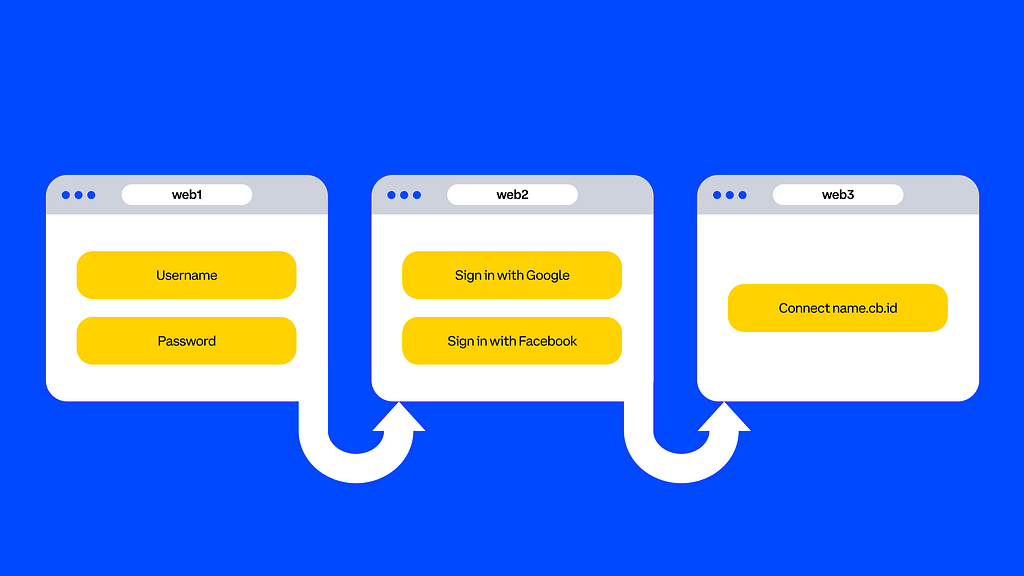
Web3 has the opportunity to address many of web2’s flaws. With crypto, you control the keys to your identity and your security is in your own hands. But let’s be realistic: web3 as it exists today is intimidating. So what do we, the web3 community, need to build to make the benefits of web3 available to everyone?
An identity for the user.
We need to make it easy to define and manage portable, interoperable, human-readable usernames that sit on rich, customizable public identities ranging from anonymous to fully public. Users should be able to maintain multiple identities for different contexts (e.g. one for work and one for gaming).
Tools to help everyone stay secure and feel secure.
Today, web3 violates one of the cardinal laws of security in that our identities are vulnerable to a single point of failure: the recovery phrase. A compromised app, device, or a social engineering attack can lead to identity theft. Multi-factor authentication (MFA) is the quintessential web2 example, and web3 will need an equivalent solution that can protect every user.
Recovery for when something goes wrong.
We’ve all forgotten a password at some point, and we shouldn’t expect recovery phrases to be any different. We can’t scale an ecosystem where losing a recovery phrase can cost someone access to their livelihood — users need ways of regaining access. Products like social recovery or the multi-party computation (MPC) technology that powers Coinbase’s dapp wallet are creating more forgiving experiences that can enable broader web3 adoption.
Signals for trust and legitimacy.
Passports only work because governments attest to their legitimacy. The utility of web3 identity will also rely on trusted parties attesting to the legitimacy of an identity. Users will need ways of collecting, managing, and communicating “attestations” that validate their credentials and legitimacy. Applications will need ways of both issuing and verifying the legitimacy of a user’s identity and credentials.
Interoperability across web2 and web3.
Over time, the concepts of “web2” and “web3” will blur and users who are later on the adoption curve won’t see a clear difference between the two. They will expect to be able to seamlessly access both “web2” and “web3” from a single identity and set of credentials, and we need to enable that experience. Similarly, we need to provide users with a chain-agnostic identity that they can use across all of web3.
Building a robust web3 identity layer will require deep focus from strong teams that can build and iterate rapidly. This will often mean building and refining locally before scaling globally (and in a decentralized way). Coinbase and organizations like us need to embrace this long-term vision from the start: open source, open standards, and close collaboration with the broader web3 ecosystem.
Most importantly, we can’t lose sight of the core promise of web3 identity. We need to build in a way that prioritizes privacy, security, and control for the user while being intuitive, forgiving, and trustworthy.
We’ve started this journey with organizations like ENS and Verite to enable a free web3 identity (cb.id) for everyone, and we’ll continue expanding our identity offerings. Watch this space: this is only the beginning of an exciting new chapter for identity and web3 for Coinbase and for the web3 community at large.
What Web3 Identity Needs was originally published in The Coinbase Blog on Medium, where people are continuing the conversation by highlighting and responding to this story.
Read more on Coinbase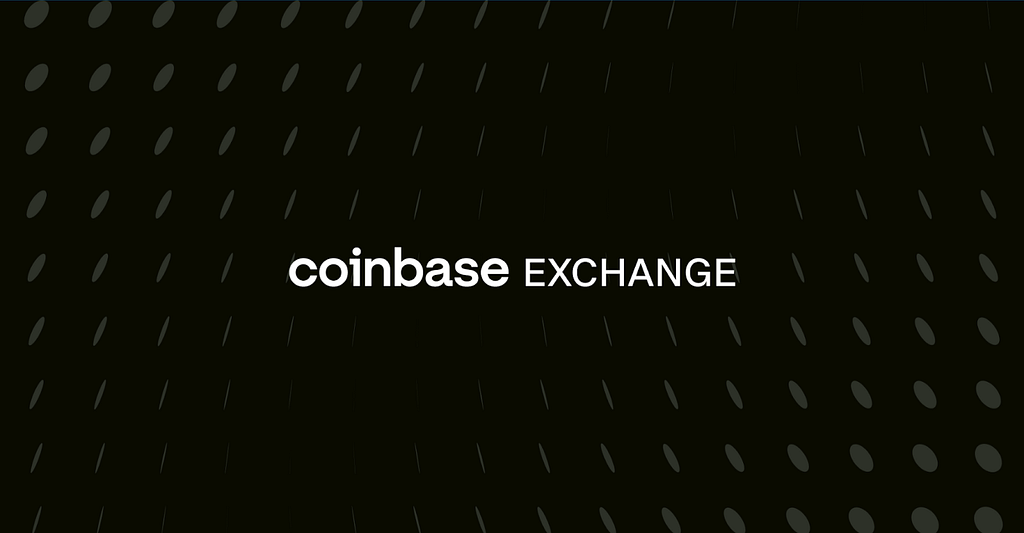
On Tuesday, September 20, 2022 at approximately 5pm ET, Coinbase Exchange will implement a new fee structure to account for changes in global crypto trading volumes and asset prices, lowering the monthly trading volume required to qualify for the mid and upper tiers of our fee schedule. The new fee schedule will be implemented on Coinbase Exchange, Pro, and Advanced Trade.
In order to respond to client needs, Coinbase periodically updates pricing. All fee updates are shared prior to being implemented.
New Fee Schedule
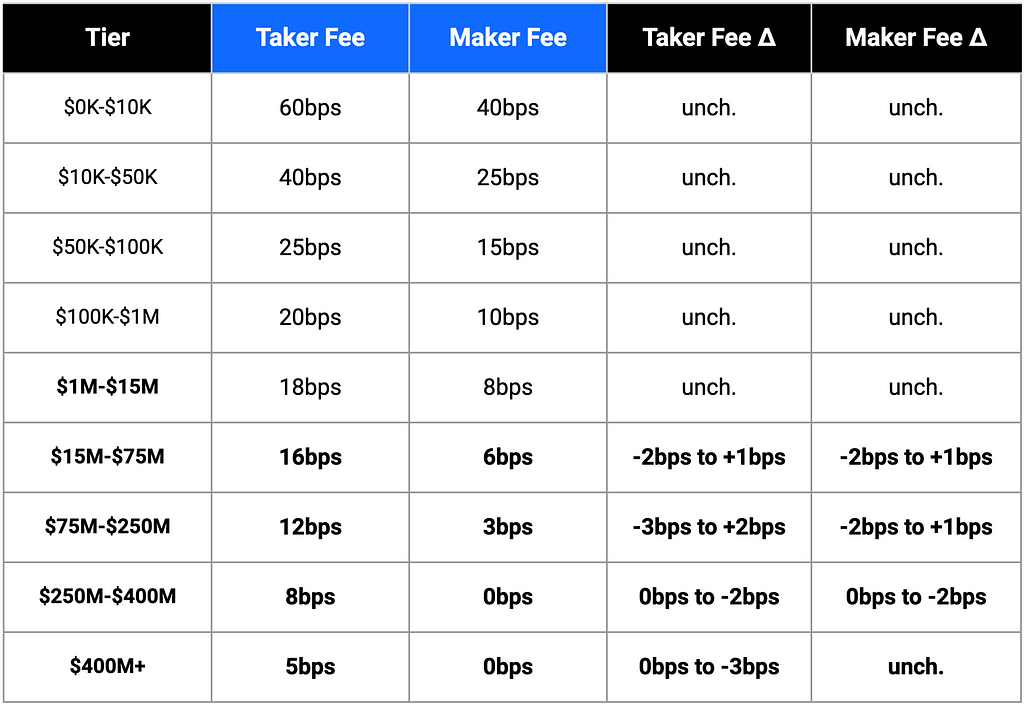
The calculation for volume tiers will continue to be based on trailing 30 day volume.
Coinbase Exchange fee updates — September 2022 was originally published in The Coinbase Blog on Medium, where people are continuing the conversation by highlighting and responding to this story.
Read more on CoinbasePosted on 2024 Feb 10, 05:36
Telegram: "CyberGenieHackPro" Web: https (://) cybergeniehac kpro (.) x y z W/A: +1-2-5-2-5-1-2-0-3-9-1. If you ever find yourself in a situation where you are hopeless with no one to trust or sincerely confide in because you trusted a bunch of crypto traders and you are on the brink of losing thousands or millions of dollars you have invested with them, I tell you this, worry no more, CYBER GENIE HACK PRO is your redemption. Losing is always hurtful, now imagine losing all you have labored for all your life because you trusted a total stranger on the internet because they promised you a better or probably a luxurious life if you could invest in their trading Bots or website. All I had to do was create an account with them and deposit my investment funds to my account wallet, unfortunately, it isn't my wallet, it's linked to theirs. I was in great disarray when I found out about their ridiculous deeds. I thought they were my friends, they were friendly and engaging. We talked for hours and they made lots of promises little did I know they were rippers. Luckily I was able to get the best recovery team of Crypto recovery experts your time and money can buy for you on the internet, CYBER GENIE HACK PRO. I want to introduce these guys to you all here searching to "hire a professional hacker" that can trace and recover your stolen money, a private investigator, hack a device, or upgrade credit score or school grades, CYBER GENIE HACK PRO doesn't disappoint with such tasks. Find them with the information above.
ReplyPosted on 2023 Sep 26, 02:06
Can lost Bitcoin be Found or Retrieved? Generally speaking, whether lost bitcoin can be found or not depends on how it was lost. Considering the quantity of missing cryptocurrency out there, people have begun offering services to help recover lost bitcoin. These include data recovery specialists, but you need a professional recovery expert like Mr Thomas to help you get back your lost bitcoin. Contact them to recover lost bitcoin, bitcoin cash, as well as all other forms of cryptocurrency. And you can be sure that no matter how long it has been lost, you will still get your bitcoin worth. Contact their support team for further assistance: HQRECOVERY22 at G M A I L dot C O M You Can Whatsapp or Text: + 1 3 2 3 3 8 8 5 7 1 5 NO UPFRONT PAYMENT! 303 Second St., Suite 900 South Tower, San Francisco, CA 94107 Thank me later.
ReplyPosted on 2023 Sep 24, 16:22
FAST CREDIT REPAIR SERVICE I started the year with a bad credit score, lingering debts and derogatory record which affected my ability to finance a new home, including a new car. I tried a few credit restoration firms but all were abortive until I saw a post about HACK VANISH CREDIT SPECIALIST. I reached out to them and surprisingly they helped cleaned-up my derogatory and raised my FICO score to 782 across all three bureaus, within a short period of time I got qualified for a new home, and also purchased my dream car. Anyone with related issues can reach out to them for assistance via [Hackvanish @ Gmail. Com] or Phone: (2 0 9 ) 3 3 0 - 3 0 4 7.
ReplyPosted on 2022 Nov 30, 02:59
Get in touch with Blu hack solutions to help recover your cryptocurrencies or funds from fake investments, trading, or accidentally sending to the wrong address regardless of how long. They're fast, precise, legit, transparent, and everything legal you can think of. I do not have much to say, but this is to the public and I can assure you of also getting back your lost BTC. For inquiries about Blu hack solutions, see below their information. Em............bluhack @ solution4u com +1305 209 57 45 Thanks for your time reading this statement. MARY.
ReplyPosted on 2022 Oct 12, 18:31
I was particularly unhappy hearing from my friends that its almost impossible to recover lost bitcoin, but I did my research and came across blockchainrecall.com via a blog. THANKFULLY!!! I got every dime I lost back and QUICK or WhatsApp: + 1 (917) 267-2755
ReplyPosted on 2022 Apr 19, 21:56
NO UPFRONT PAYMENT! From my experience, I guess the best way to avoid online scam is by having a very thorough investigation about the subject matter. If i had this advice i would probably have not gone through the ordeal i went through some months past. Binary Options is a blessing to some and curse to many, it almost ruined me. Gracefully, i got in contact with a certified recovery specialist ( Mr Tessy ) who helped me with refunds. I can’t say for any other recovery expert but this ( Mr Tessy ) came to my rescue and I RECOMMEND ONLY his service. Contact our support team for further assistance: HQRECOVERY22 at G M A I L dot C O M WhatsApp: + 1 4 0 8 8 7 2 5 7 4 0 You Can Also Text Or Call: + 1 4 0 8 8 7 2 5 7 4 0 NO UPFRONT PAYMENT! 303 Second St., Suite 900 South Tower, San Francisco, CA 94107 Thank me later.
ReplyPosted on 2022 Mar 24, 04:37
GET RICH WITH BLANK ATM CARD ... Whatsapp: +18033921735 I want to testify about Dark Web blank atm cards which can withdraw money from any atm machines around the world. I was very poor before and have no job. I saw so many testimony about how Dark Web Cyber hackers send them the atm blank card and use it to collect money in any atm machine and become rich.(dwchzone@gmail.com) I email them also and they sent me the blank atm card. I have use it to get 250,000 dollars. withdraw the maximum of 5,000 USD daily. Dark Web is giving out the card just to help the poor. Hack and take money directly from any atm machine vault with the use of atm programmed card which runs in automatic mode. You can also contact them for the service below * Western Union/MoneyGram Transfer Hack * Bank Transfer Hack * PayPal / Skrill Transfer Hack * Crypto Mining Hack * CashApp Transfer Hack Email: dwchzone@gmail.com Text & Call or WhatsApp: +18033921735 Visit: https://darkwebcycberhackers.com
ReplyPosted on 2020 Oct 16, 06:45
Am short of words for the amazing profit you helped me earn in just a week with binary options strategy am so sorry I doubted at the beginning, I invested $200 and earn $2,500 in just one week, and kept on investing more, today I am financially successful, you can contact him via email: carlose78910@gmail.com Via whatsapp: (+12166263236) I advice you shouldn't hesitate. He's great.
ReplyPosted on 2020 Oct 2, 21:32
I was scammed by a Binary online website in march. I lost about $35,000 to them and they denied all my withdrawal request, and gave me all sort of filty request. It was a really hard time for me because that was all I had and they tricked me into investing the money with a guarantee that I will make profit from the investment. They took all my money and I did not hear from them anymore. I was able to recover all the money I lost just last month with the help of Alliedrecovery. I paid 10% of the recovered funds as his service charge after I got all my money back. I am really grateful to him because I know a lot of people here have been scammed and need help. Contact him via contact@alliedrecovery . Org or WhatsApp: +1 (425) 312-1045
ReplyPosted on 2020 Apr 27, 20:54
Hi, for two years I had $95,000 in debt, including $36,420 in credit card debt. My credit score was nothing to write home about. I managed to get most of my debt removed in bankruptcy and i was left with $7,000 car loan and $51,000 in student loans. Determined not to repeat my mistakes again I was recommended by a credit consultant to contact 760PLUS CREDIT SCORE who would help fix my credit score and clear my loans she referred me to her hacker friend she has met years ago who specializes in fixing credit score. I contacted him through 760PLUSCREDITSCORE@GMAIL.COM the following day, it took him some time to get back to me, because he was fully book, after a while he responded and helped me out. He started from raising my credit score to 799 after which he cleared my outstanding pending bills. I bounced back quickly, I am currently on my feet and on my way to buying a house. All thanks to 760 Plus. You text : +1(304)-774-5902.
ReplyPosted on 2020 Apr 23, 10:18
760 Plus Credit Score have proven beyond doubt to be second to none in terms of topnotch credit repair services. They did some mind-blowing works on my credit, that I think enumerating them on this public forum wouldn’t be necessary. It’s really needless having a second thought before contacting this top notch credit specialist for all kind of credit repair. After they boosted my score and brought my report back to excellent, I had to also do that of my wife and it was done in 72hours. I can comfortably recommend them (760pluscreditscore@gmail.com or +1(304) -774 -5902). Contact and be bold to share your own testimony.
ReplyPosted on 2020 Mar 18, 12:53
I was beyond depressed as the cryptocurrency ecosystem lost over $90bn in total market capitalization under 24hrs as a result of the uncertainty the COVID-19 pandemic brought into the market. Bitcoin fell from $7,800 to $3,800 within 24 hours. I lost a little over $12,850 under 24hrs. I am quite proactive so instead of folding my arms sad and doing nothing I began looking for ways to make my money back and I opted for cloud mining with THEBTCHASH dot COM after doing an extensive research, the rest they say is history but to begin mining bitcoins, you'll need to acquire a significant number of bitcoin mining hardware components running into millions of dollars. In the early days of bitcoin, it was possible to mine with your computer CPU or high speed video processor card. Today that's no longer possible. Bitcoin mining with anything less will consume more in electricity than an average American will earn in 10 years. TheBTCHash Cloud Mining Software V3.0 bridges this gap. The software Is an advanced cloud-based mining software connected to strong physical mining plants for optimum bitcoin generation. With Speed: 79.14 quintillion hashes per second (EH/s) I was able to mine a total of 3.89 bitcoins ($19,380) under two hours. The process was seamless. Worth my time and resources expended. The bitcoin's crash in price affected me terribly but now I am back and even better! THEBTCHASH is such a life saver!
ReplyPosted on 2020 Mar 18, 12:50
I was beyond depressed as the cryptocurrency ecosystem lost over $90bn in total market capitalization under 24hrs as a result of the uncertainty the COVID-19 pandemic brought into the market. Bitcoin fell from $7,800 to $3,800 within 24 hours. I lost a little over $12,850 under 24hrs. I am quite proactive so instead of folding my arms sad and doing nothing I began looking for ways to make my money back and I opted for cloud mining with THEBTCHASH dot COM after doing an extensive research, the rest they say is history but to begin mining bitcoins, you'll need to acquire a significant number of bitcoin mining hardware components running into millions of dollars. In the early days of bitcoin, it was possible to mine with your computer CPU or high speed video processor card. Today that's no longer possible. Bitcoin mining with anything less will consume more in electricity than an average American will earn in 10 years. TheBTCHash Cloud Mining Software V3.0 bridges this gap. The software Is an advanced cloud-based mining software connected to strong physical mining plants for optimum bitcoin generation. With Speed: 79.14 quintillion hashes per second (EH/s) I was able to mine a total of 3.89 bitcoins ($19,380) under two hours. The process was seamless. Worth my time and resources expended. The bitcoin's crash in price affected me terribly but now I am back and even better! THEBTCHASH is such a life saver!
ReplyPosted on 2020 Feb 17, 08:41
I have being a victim of these fake brokers. I invested about $390K MAGNUM option and all could do in my first withdrawal was $59k. Then my money started going down the drain till i was left with only the bonus they said i couldn’t withdraw until i fund my account again. The trend continued and i lost everything.Not one dollar was left. I almost died knowing i was scammed. I was very determined to get my money back so i had to hire Regalrefunder at gmail dot com who recovered 80% of my money including my bonuses to me. The moral of this story is for everyone to be very vigilant about the kind of broker you invest with and if you have lost some money don't give up the quest to get your money back
ReplyPosted on 2020 Feb 2, 07:52
I got ripped off by an investment company named cryptoallday by sending them all my life savings, I invested $70,000 of my trust-fund money and was hoping to triple my capital in a week as they promised. When it was time to withdraw my profit I was being coerced into sending more money for my cashout which I ignorantly did.. To cut the long story short I lost all the money and was left with nothing so I began searching the whole web for somebody who could recover stolen bitcoins. I searched for at least 4 months and came across different rippers again but I couldn't quit because I had nothing more to lose paying anybody to get my $100,000 (total amount I paid them). Finally, I came across a recovery company CREDITSOLUTION63 and they did excellent in helping me recover my bitcoins. I was counseled by their group of experts and learned more about Bitcoins, at the same time recovered my total money lost, I can confidently refer anybody that was in my situation to them because I'm sure they offer genuine help. Be careful out there guys Contact Mr Dennis Email: CREDITSOLUTION63 at GMAIL dot COM WhatsApp: +1 9176634684 You Can Also Text Or Call: +1 9176634684 NO UPFRONT PAYMENT!
ReplyPosted on 2020 Feb 2, 07:48
NO UPFRONT PAYMENT! From my experience, I guess the best way to avoid online scam is by having a very thorough investigation about the subject matter. If i had this advice i would probably have not gone through the ordeal i went through some months past. Binary Options is a blessing to some and curse to many, it almost ruined me. Gracefully, i got in contact with a certified recovery specialist ( CREDITSOLUTION63@GMAIL.COM ) who helped me with refunds. I can’t say for any other recovery expert but this (astrahacklord) came to my rescue and I RECOMMEND ONLY his service. Contact Below: Email: CREDITSOLUTION63 AT GMAIL DOT COM WhatsApp: +1 9176634684 You Can Also Text Or Call: +1 9176634684
Reply